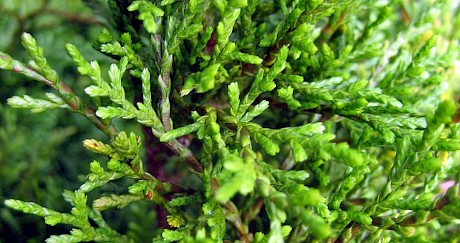Pohutukawa (Metrosideros excelsa)
History
To the Maori pohutukawa is a sacred tree, for it is from the ancient trees on the cliffs at Te Reinga that the spirits of the dead left this land. Legend tells us that the red of the flowers comes from the blood of the mythical hero Tawhaki, who fell to his death from the sky. The Maori made some use of the wood of pohutukawa; mainly for small implements, paddles and mauls.
When Europeans first arrived in New Zealand they found pohutukawa reaching form Cape Reinga south to Poverty Bay and Urenui and on the shores of the Rotorua lakes. It has now been planted over most of New Zealand, mainly in areas close to the sea, with the oldest planted trees being at least 150 years old. (Burstall & Sale)
Early Europeans used pohutukawa extensively for the curved members of boat frames and its numbers were greatly reduced in areas adjacent to boat building yards. Because it was so hard it was usually worked green which often led to problems later on (Clifton). When straight lengths could be obtained it was used for piles, stringers, bridge and wharf planking and mining timbers.
However it is probably in areas of tradition and nostalgia that pohutukawa plays the greatest role in our lives today, for images of the tree appear in photographs, paintings and Christmas cards. It is found in plays, poems and literature and even the titles of Mills & Boon novels (Project Crimson).
Tree size
Burstall and Sale (1984) contains records of many large pohutukawa. Some of these are listed below (all measurements in metres): -
Trunk diameter - Height - Crown diameter
Mangonui 3.24 - 18 - 36.5
Tiritiri Matangi 3.20 - 25 - 52
Mayor Island 3.22 - 17.4 - 36.5
Te Araroa 6.46 - 20.3 - 40.3
Lower Hutt 2.40 - 14.6 - 15 [planted ca. 1860]
New Plymouth 2.27 - 20.2 - 19.1 [planted 1874]
Timber
The wood is a rich reddish brown in colour, heavy, compact and of great strength. It is reputed to be durable and resistant to the marine worm, teredo. As already indicated it is easier to work when green but often shrinks later. (Clifton)
The major problem with the timber is that the growth habit of the tree makes it almost impossible to obtain long, straight pieces.
While there appears to be no published data on the timber properties of pohutukawa, details for northern rata do exist. These will be similar to pohutukawa:
Density: 880 kg/m³ (500 kg/m³ )
Moisture content: 70% (130%)
Tangential shrinkage from green to 12% m.c 6.9% (4.7%)
Radial shrinkage 3.8% (2.2%)
Modulus of rupture 114 MPa (90Mpa))
Modulus of elasticity 21.2 GPa (9 Gpa)
(As a comparison, figures in brackets are for P radiata)
Potential
Because of its strength properties, density and presumed durability, there is good reason to consider growing pohutukawa as a timber tree. The drawback of course is its apparent inability to grow as a straight, single trunked tree. Anecdotal evidence suggests that straight, single stemmed pohutukawa do exist although they may be hybrids with northern rata. Indications are that it may be possible to select seed trees with the required characteristics of straightness and upright growth and grow seedlings from these at spacings close enough to encourage erect growth.
The growth rate is reasonably fast. Diameter M.A.I of the two planted trees recorded above indicates that an annual diameter growth of about 2 cm is possible. More accurate data from measurements of trial plantings (Pardy et al, 1992) gives pohutukawa an M.A.I of 35 cm for height growth and 0.95 cm for diameter for trees in the 51 – 60 age class.
Research requirements
First we need to determine the basic site requirements of the species by field evaluation. At the same time locate straight growing pohutukawa (or pohutukawa x northern rata) and propagate plants for a trial. This would probably involve spacing and site preparation considerations and the possible use of nurse species for nitrogen production and an intermediate crop. If, on reasonable sites, pohutukawa will grow at about 1 to 1.5 cm diameter annually, it should be possible to grow millable trees in 50 to 60 years – or less.
References
- Burstal S W & Sale E V 1984. Great Trees of New Zealand
- Clifton N C 1990. New Zealand timbers
- Pardy G F, Bergin D O & Kimberley M O 1992. Survey of Native tree plantations. FRI Bulletin 175
- Project Crimson 1999 The living library. http://www.projectcrimson.org.nz/living_library.html
Species profile by Ian Barton


